The Killing of Journalists in Iraq
2013: Another year of slaughter in Iraq claims the lives of at least 21 media professionals
In Iraq, at least 404 media professionals have been killed since the US invasion in 2003, among them 374 Iraqis, according to The BRussells Tribunal statistics. The impunity in Iraq is far worse than anywhere else in the world.
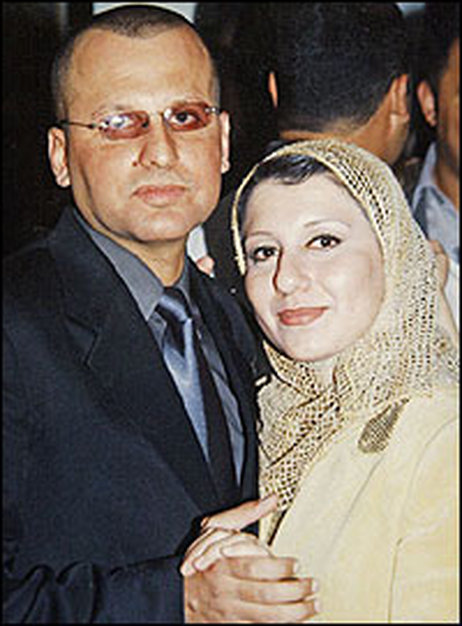
Dr. Yasser Salihee (here with his wife Dr. Raghad Wazzan) gave up his job at Yarmouk Hospital to become a journalist.
In memory of Dr Yasser Salihee, an Iraqi special correspondent for the news agency Knight Ridder, killed on 24 June 2005 by a single bullet of an American sniper as he approached a checkpoint that had been thrown up near his home in western Baghdad by US and Iraqi troops. Since May 2005, Dr. Salihee had been reporting on the similarities between the death squads used in El Salvador to obliterate their “insurgency” and the US military’s creation of the “Wolf Brigade” that had been unleashed to eliminate the Iraqi Resistance. Salihee had been gathering evidence that US-backed Iraqi Ministry of Interior forces had been carrying out extra-judicial killings.
We believe that he was assassinated because he came too close to the truth. There is serious doubt that the shooting was “an accident”. Nevertheless, the Committee for The ‘Protection’ of Journalists (CPJ) has thrown Dr Yasser Salihee in the dungeons of history. He doesn’t figure in any of their death lists.
Impunity for killers of media professionals in Iraq
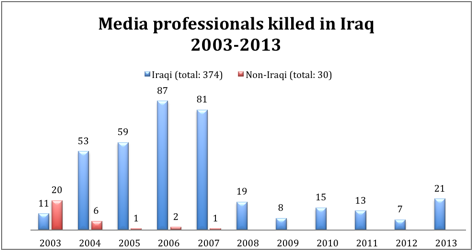
In Iraq, at least 404 media professionals have been killed since the US invasion in 2003, among them 374 Iraqis, according to The BRussells Tribunal statistics. The impunity in Iraq is far worse than anywhere else in the world. None of the journalist murders recorded in Iraq in the past decade has been solved. Not a single case of journalists’ killings has been investigated to identify and punish the killers.
Hassan Shaaban, head of the Center for the Legal Protection of Journalists, told Human Rights Watch (HRW) that, “Terrorists are systematically targeting journalists,” but that “the government is not protecting people.”
The New York Times reported on 24 December 2013 that: “Security forces have found lists of journalists targeted for assassination during raids on militant hide-outs in Mosul, and many journalists have stopped reporting in the streets or attending news conferences.”
Maliki’s security forces are not interested in protecting the journalists on this dead list.
Maliki’s harassment of journalists
Human Rights Watch stated: “Journalists in Iraq face a double threat, from armed gangs gunning them down and prosecutors charging them, all because of what they write. The recent spate of assassinations of journalists has had a chilling effect on journalists, who risk being prosecuted by the very authorities that are supposed to protect them.”
HRW: “At the same time, Iraqi prosecutors have stepped up criminal prosecutions of journalists for defamation and have increased other harassment of journalists. Three journalists told Human Rights Watch in November that security forces arrested them and confiscated their equipment after they covered politically sensitive topics, such as poor security, corruption, and the government’s inadequate response to the needs of people affected by flooding. Another journalist told Human Rights Watch that police arrested him on charges of defamation, a crime in Iraq’s penal code, for an article accusing officials of corruption.”
“Since the start of protests in Iraq in February 2011 over widespread corruption and lack of services, journalists have faced escalating attacks and threats, including from members of the government’s security forces.”
21 Iraqi media professionals assassinated in 2013
In 2013, the BRussells Tribunal has listed 21 assassinated media professionals, while the two best known advocacy groups for journalists: the Committee For The Protection of Journalists (CPJ) and Reporters Without Borders (RSF) listed respectively 12 and 11 murdered Iraqi colleagues.
Here are the names of the media professionals killed in Iraq in 2013:
1- Hamid Rashid Abbas (Not listed by CPJ – Not listed by RSF)
Journalist, formerly of Jumhuriah (Republic) newspaper.
06/02/2013
Iraqi Journalists Syndicate condemned, in a statement issued today 7 Feb, the assassination of Hamid Rashid Abbas, who worked in formerly Jumhuriah (Republic) newspaper southwest of Baghdad last night as he left the mosque after night prayers. An armed group assassinated the journalist in Baghdad yesterday evening Southwest of Baghdad.
2- Muwaffak al-Ani (Not listed by CPJ – Not listed by RSF)
Radio broadcaster in Baghdad and one of Iraq’s best-known media voices. 06/05/2013
Muwaffak al-Ani was one of Iraq’s longest-serving broadcasters. He began his career in radio and television in 1962 at Radio Baghdad and had worked for several of the country’s major networks since then. He also taught radio journalism. According to media reports he was killed, along with his brother and several others, when a bomb exploded outside the Mansour Mosque in west Baghdad during evening prayer on Monday.
3- Zamel Ghannam al-Zoubaie (Not listed by CPJ – Not listed by RSF)
Journalist in the Baghdad bureau of the Iraq News Network.
09/06/2013
The International Federation of Journalists (IFJ) Tuesday condemned the murder of an Iraqi journalist who was killed in a terrorist attack in Baghdad.
The body of well-known journalist, Zamel Ghannam Al Zoubaie, was found in the Al Washwash area of western Baghdad.
4- Imad Ali Abbass (Not listed by CPJ – Not listed by RSF)
Journalist.
10/09/2013
A journalist was killed when an improvised explosive device placed in his car went off on Tuesday, Sep. 10, in northern Mosul. The car belonged to a journalist called Imad Ali Abbass.
5- Tahrir Kadhim Jawad (Not listed by CPJ – Not listed by RSF)
Freelance cameraman for US-funded Al-Hurra TV satellite channel.
05/10/2013
A freelance cameraman for US-funded Al-Hurra TV satellite channel was among 10 Iraqis killed in violence across Baghdad and the north of the country on Monday. Tahrir Kadhim Jawad was killed when a magnetic “sticky bomb” attached to his car detonated in the town of Garma, 50 km (30 miles) west of the Iraqi capital. Jawad was driving to Baghdad to deliver footage when the bomb exploded. He died instantly.
6- Mohammed Ghanem
Cameraman of the independent TV channel Al-Sharqiya.
07/10/2013
Gunmen opened fire on Mohammed Karim al-Badrani, correspondent for the independent TV channel Al-Sharqiya, and Mohammed Ghanem, a cameraman, while they were filming in the Al-Sarjkhana area of Mosul in Nineveh province, the station said. The journalists were hit in the head and chest, the reports said.
7- Mohammed Karim al-Badrani
Correspondent for the independent TV channel Al-Sharqiya.
07/10/2013
Gunmen opened fire on Mohammed Karim al-Badrani, correspondent for the independent TV channel Al-Sharqiya, and Mohammed Ghanem, a cameraman, while they were filming in the Al-Sarjkhana area of Mosul in Nineveh province, the station said. The journalists were hit in the head and chest, the reports said.
8- Saad Zaghloul (Not listed by CPJ – Not listed by RSF)
Reporter for several newspapers in the northern city of Mosul.
08/10/2013
Saad Zaghloul, who reported for several newspapers in the northern city of Mosul, was shot and killed outside his home
9- Bashar al-Nuaimi
Cameraman working for local TV channel al-Moussilyah.
24/10/2013
In the northern city of Mosul, police said gunmen killed Bashar al-Nuaimi, a cameraman working for local TV channel al-Moussilyah, as he was walking near his house.
10- Alaa Edward Boutros
Cameraman in Nineveh al-Ghad channel.
24/11/2013
Unidentified gunmen opened fire targeting Alaa Edward Boutros in the north of Mosul. The victim belong to Christian religion. ‘The victim used to work as a cameraman in Nineveh al-Ghad channel and he quit his job after receiving threats of killing him in case he remained working in the channel.
11- Wahdan al-Hamdani (Not listed by RSF)
Cameraman for the Al Taghee television station in Baghdad.
27/11/2013
Wahdan Al-Hamdani, a cameraman for the Al Taghee television station in Baghdad, was shot to death while covering a funeral in the southern city of Basra, according to a statement from the United Nations.
12- Aadel Mohsen Husain (Not listed by CPJ)
Reporter for a number of news media in Iraq.
02/12/2013
Aadel Mohsen Husain, a reporter for a number of news media in Iraq, was shot to death in the northern city of Mosul. There was no immediate information on who carried out the attack. The killing of Husain, 43, was confirmed by the Iraqi Journalists Rights Defense Association.
13- Kawa Ahmed Germyani
Editor-in-chief of Rayal magazine and a correspondent for Awene newspaper.
06/12/2013
Kawa Ahmed Germyani, investigative journalist, was shot in the head and chest in front of his mother at his home in the town of Kalar, which lies south of Iraqi Kurdistan’s second-biggest city Sulaimaniyah. Germyani had received threats, and he was taken to court by politicians and officials over his work to uncover corruption.
14- Nawras al-Nuaimi
TV presenter in Al-Mawsiliyah Channel.
15/12/2013
An unknown armed group murdered a TV presenter Nawras Al-Nuaimi who worked in Al-Mawsiliyah Channel near her house in Al-Jazaer District in Mosul
15- Muhanad Mohammed (Not listed by CPJ – Not listed by RSF)
Journalist who worked for both foreign and Iraqi media.
20/12/2013
Muhanad Mohammed, a journalist who worked for both foreign and Iraqi media, was among those killed in one of the suicide bombings on Thursday. He was the seventh journalist to be killed in Iraq in less than three months.
16- Raad Yassin
Chief news editor of Salaheddin TV.
17- Jamal Abdel Nasser
Producer of Salaheddin TV.
18- Mohamed Ahmad al-Khatib
Cameraman of Salaheddin TV.
19- Wissam al-Azzawi
Presenter of Salaheddin TV.
20- Mohamed Abdel Hamid
Archives manager and editor of Salaheddin TV.
(?) Unknown
Staff Member of Salaheddin TV.
23/12/2013
Five attackers stormed the offices of the channel owned by the provincial government of Salah al-Din in the city of Tikrit north of Baghdad, one blowing up a suicide car bomb at the gate and two more setting off explosive suicide belts inside, police said. Two more were killed by security forces. Six channel staff died in addition to the attackers, and six others were wounded, police and health officials said. A security source said one of the dead was a female presenter. Earlier in 2013, the Iraqi government suspended the licenses of 10 stations, including Salah al-Din, accusing the channels of sectarian incitement for their coverage of Sunni protests in Hawija outside of Kirkuk.
21- Omar al-Dulaimi (Not listed by CPJ – Not listed by RSF)
Reporter for one of the local agencies in Ramadi
31/12/2013
Killed when he was covering the armed clashes between the security forces and gunmen in the city of Ramadi, where he was shot by sniper fire in the head. Omar al-Dulaimi, a graduate of the Department of Information in the Faculty of Arts, University of Anbar
Scores of Iraqi media professionals not listed by CPJ and RSF
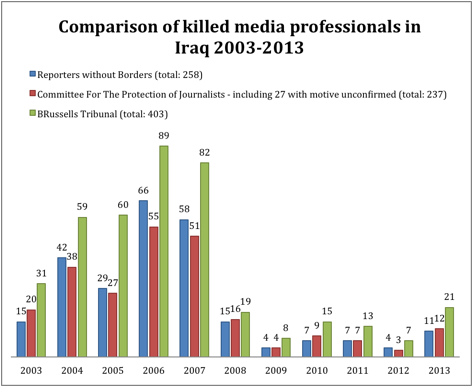
The question is why so many media professionals, assassinated in Iraq, were not reported by CPJ and RSF?
One of the reasons can be found on their websites.
RSF: “Journalists killed” in the table includes only cases in which Reporters Without Borders has clearly established that the victim was killed because of his/her activities as a journalist. It does not include cases in which the motives were not related to the victim’s work or in which a link has not yet been confirmed.
Note CPJ: CPJ’s list of killed journalists is different from other organizations. Why?
When CPJ publicizes journalists killed on duty, it cites only those cases in which the motive has been “confirmed.” Lists compiled by other organizations may include journalists whose killings CPJ has not connected to their work with reasonable certainty. Other organizations may also list media support workers, such as drivers and interpreters. CPJ maintains a separate list of media support workers killed on duty. CPJ also maintains a separate list of killed media professionals for which the motive is “unconfirmed”.
But a quick glance at The BRussells Tribunal database should make clear that their explanation doesn’t make sense in many cases.
It is hard to imagine that the unreported killing of 144 Iraqi media professionals (RSF) and 180 Iraqi media professionals (CPJ) between 2003 and 2013 was not related to their work.
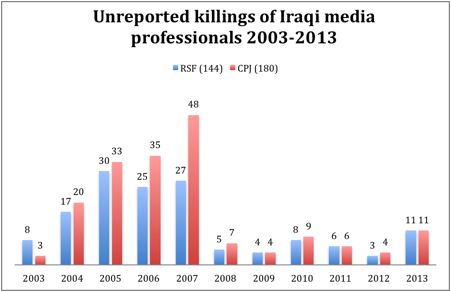
But then how can the discrepancy between the RSF and CPJ lists and the list of The BRussells Tribunal be explained?
It is a well-established fact that since the invasion of 2003 the corporate media have consistently downplayed mortality figures. The killing of media professionals is no exception. It’s obvious that the journalist advocacy groups in the West are reluctant to give the real casualty figures of their colleagues who lost their lives under the ruthless occupation of the US/UK, an occupation that is still ongoing. So they narrow their criteria of who should be included in their lists. This is an objectionable attitude, especially because it concerns professional colleagues.
The difference with the situation in Syria is blatantly clear. But then CPJ is located in the USA, the country that illegally invaded and occupied Iraq, while in Syria the USA is on the side of the ‘opposition’. Since the ‘civil war’ in Syria in 2011 RSF has come up with a new category of journalists. They call them “netizens” (Media activists) and citizen journalists. This makes sense. A difference should be made between media ‘professionals’ and media ‘amateurs’.
CPJ has another opinion: “CPJ does not distinguish between professional and amateur journalists like some organizations. We also do not fixate on labels commonly used in the Syrian conflict such as “media activist” and “citizen journalist.” Instead, we care only about what the individual was doing. Did he or she show a consistent effort in gathering, producing, and publicly disseminating the news? That’s a journalist in our book.”
If only they had applied the same criteria for Iraqi ‘journalists’ ……
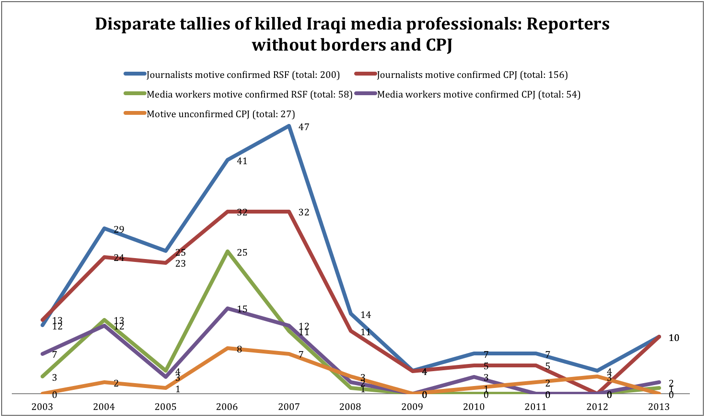
CPJ keeps 3 separate lists: ‘journalists motive confirmed’, ‘media workers motive confirmed’ and ‘motive unconfirmed’.
RSF also keeps 3 separate lists: ‘journalists killed’, ‘media assistants killed’ and since 2011 ‘Netizens and citizen journalists killed’.
“Now, can we come up with a consensus all-inclusive journalist/media worker death tally rather than these disparate counts?” (Eason Jordan)
Media manipulation
Media manipulation in the USA didn’t start in 2003.
John Catalinotto, International Action Center (IAC): “935 lies. The Bush gang lied 935 times between Sept. 11, 2001, and March 19, 2003, to justify the invasion of Iraq. Bush lied 259 times. The biggest lie was that Iraq had “weapons of mass destruction”. And that Saddam Hussein worked with al-Qaida. Why is the number of lies important? There were 935 opportunities to question the liars. The 935 lies are proof that the entire U.S. ruling class is responsible for the conspiracy to wage war on Iraq.”
“The millions who marched against the war knew these were lies. You did not have to be Einstein. But the entire ruling class and its institutions colluded. The Pentagon went along willingly. The State Department presented the false statements to the United Nations. Congress voted the funds.”
“No major corporate media questioned or challenged these lies. The influential New York Times and the Washington Post supported the war drive. Nor did the media allow war opponents to expose the lies.”
TheCommonIlls commented on 18 December 2012 about CPJ not listing the assassination of an Iraqi journalist:
“Their list is missing Ziyad Tarek (not the 2007 death which is what the CPJ friend and I went round and round about). Al-Shorfa reported on Ziyad Tarek’s November 2012 death noting that he was killed in Baqubah — a sticky bomb attached to his car — that would be murder, CPJ, and that he was “the main news anchor” at the Diyala satellite TV station.”
(…) “On the phone last week, I was told I was confused and that I was referring to Ziad Tarek al-Dibo who died in 2007. No, I wasn’t confused. CPJ is obvioulsy confused. Ziad Tarek al-Dibo did die in October 2007. But that is not the November 2012 death that was reported last month.”
“As I said on the phone, you’re supposed to be a professional outlet and you can’t even get your facts straight and you’re telling me you’re not going to write an alert on Nouri (al-Maliki) closing the satellite station by force, with the Iraqi military?”
“And, yes, that’s what I was being told. They still haven’t reported on it. They want attention for their latest ‘report’ — that can’t even include the number dead in Iraq (the report would leave you with the impression that NO journalist died in Iraq this year) — and they can e-mail and call on that but they can’t get their damn facts right. And they want to be taken seriously?”
(…) “I haven’t begged for a penny and don’t plan to. But CPJ sure begs for pennies. And then after that they can’t do their job?”
More statistics
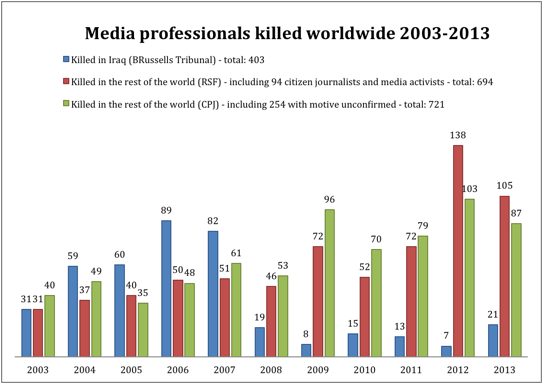
More than 36% of all the cases of killed media professionals worldwide between 2003 and 2013 occurred in Iraq. It is the deadliest country for media professionals.
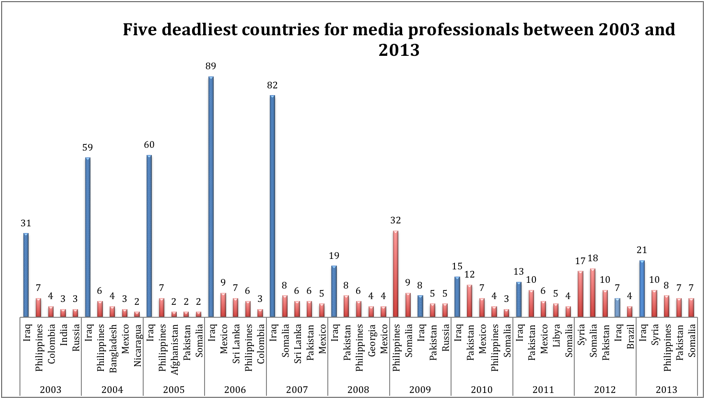
Iraq was the deadliest country for media professionals in 2003, 2004, 2005, 2006, 2007, 2008, 2010, 2011 and 2013 (if you don’t count the netizens and citizen journalists) – Figures in this graph: RSF (for the rest of the world) and The BRussells Tribunal (for Iraq). RSF’s ‘Netizens and citizen journalists’ have been left out of this graph. They are no ‘media professionals’.

